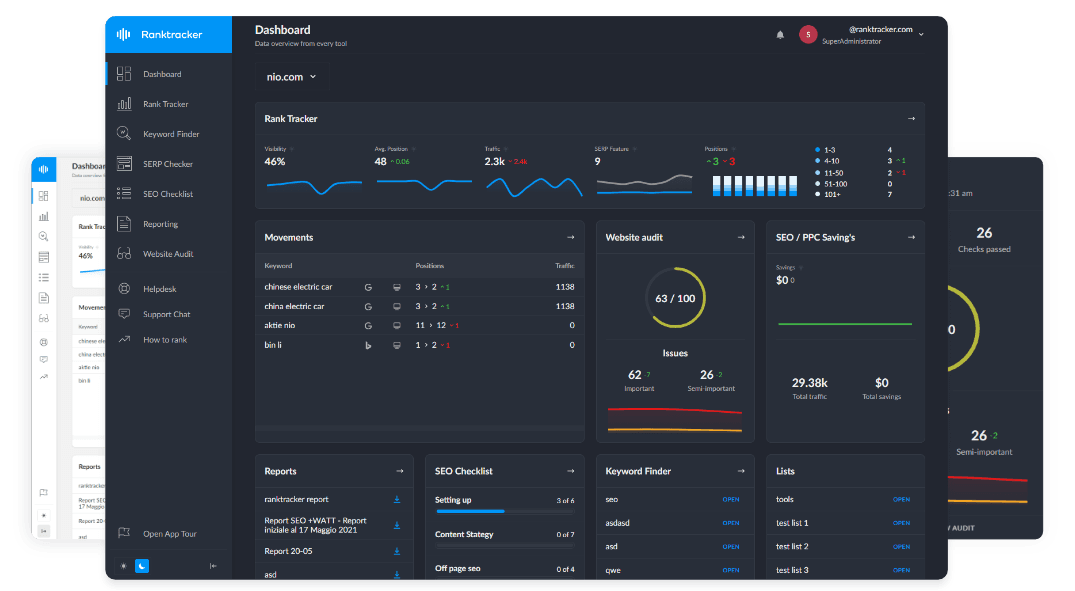Intro
The smart home industry is exploding as homeowners invest in convenience, security, and energy efficiency. But as more businesses offer smart home device installation, it’s not enough to have the skills—you need to make sure people find your services first. The right SEO strategy puts your business at the top of Google when homeowners search for help with their smart thermostats, security cameras, lighting, and more.
This guide explains exactly how to build an SEO strategy for smart home device installation, using Ranktracker’s industry-leading tools to attract high-quality leads and grow your authority online.
Why SEO Is Critical for Smart Home Installers
-
Growing demand: More homeowners are looking for professional help with setup and integration.
-
Local intent: Most searches are from people ready to book in their city or neighborhood.
-
Complex, high-value services: Customers want to trust the experts—visibility and reviews drive decisions.
1. Target the Right Smart Home Keywords
Don’t just optimize for “smart home installation.” Focus on all the terms potential customers use, covering both devices and solutions:
Examples:
-
“smart home installation [city/area]”
-
“install smart thermostat near me”
-
“home security camera installer [city]”
-
“voice assistant setup service”
-
“smart lighting installation [city]”
-
“whole home automation installer”
How to do it: Use Ranktracker’s Keyword Finder to research all relevant service/device keywords and spot long-tail opportunities your competitors may be ignoring. Include brand-specific terms (Nest, Ring, Ecobee, Philips Hue, etc.) and solution-based queries.
2. Optimize Your Google Business Profile and Local Listings
Local SEO is vital for home service businesses.
-
Choose “Home Automation Company” and related categories.
-
List every key service (thermostats, cameras, alarms, smart locks, etc.).
-
Add a detailed business description using target keywords naturally.
-
Upload photos of real installs (before/after, devices in use).
-
Collect Google reviews from satisfied clients—highlight professionalism, timeliness, and support.
3. Build SEO Landing Pages for Every Service and Device
Create dedicated website pages for your main offerings:
-
Smart thermostat installation
-
Security camera setup
-
Smart lock & entry system install
-
Voice assistant (Google, Alexa, Siri) integration
-
Whole-home automation consultations
Each page should:
-
Answer FAQs (brands supported, warranty, what’s included, integration options)
-
Use device/service keywords in titles, headers, and copy
-
Include calls to action: “Request a Quote,” “Schedule Installation,” “Call Today”
Pro tip: Use Ranktracker’s SERP Checker to analyze what’s ranking in your city and adapt your pages to win featured snippets and “People Also Ask” placements.
4. Build Local Backlinks and Citations
Authority matters for local search results.
-
List your business on major directories (Google Maps, Apple Maps, Yelp, Angi, Thumbtack, HomeAdvisor, Houzz, etc.).
-
Network with local realtors, builders, and home service providers for referral links.
-
Guest post on local home improvement blogs or participate in community tech events.
Analyze competitors with Ranktracker’s Backlink Checker to find the best citation and linking opportunities in your niche.
5. Boost Trust With Reviews and Case Studies
-
Request a review from every satisfied client, especially after completing complex or whole-home installs.
-
Feature testimonials and photo case studies on your website.
-
Respond to all feedback professionally, showing reliability and expertise.
6. Use Content Marketing to Capture Research-Phase Customers
-
Write guides and blog posts: “How to Choose a Smart Thermostat for Your Home,” “5 Benefits of Professional Smart Home Installation.”
-
Create FAQs and troubleshooting tips for the most popular devices and platforms.
-
Produce short videos showing the installation process or system overviews—great for building trust and demonstrating knowledge.
7. Track Rankings, Leads, and ROI
Set up Ranktracker’s Rank Tracker to monitor your core keywords (“smart home installer [city]”, “security camera setup near me,” etc.), website traffic, and conversion metrics. Adjust your content and local SEO based on what actually brings leads.
Key metrics to monitor:
-
Google Maps/local pack rankings
-
Organic traffic to each service page
-
Quote requests and calls
-
Growth in online reviews and citations
Conclusion
SEO for smart home device installation is your most powerful marketing channel. When you optimize for device-specific keywords, local intent, and trust factors like reviews and case studies, you put your business in front of high-intent buyers before your competitors. Using Ranktracker’s toolkit to research, optimize, and track your results, you’ll stay visible, authoritative, and fully booked in your market.

